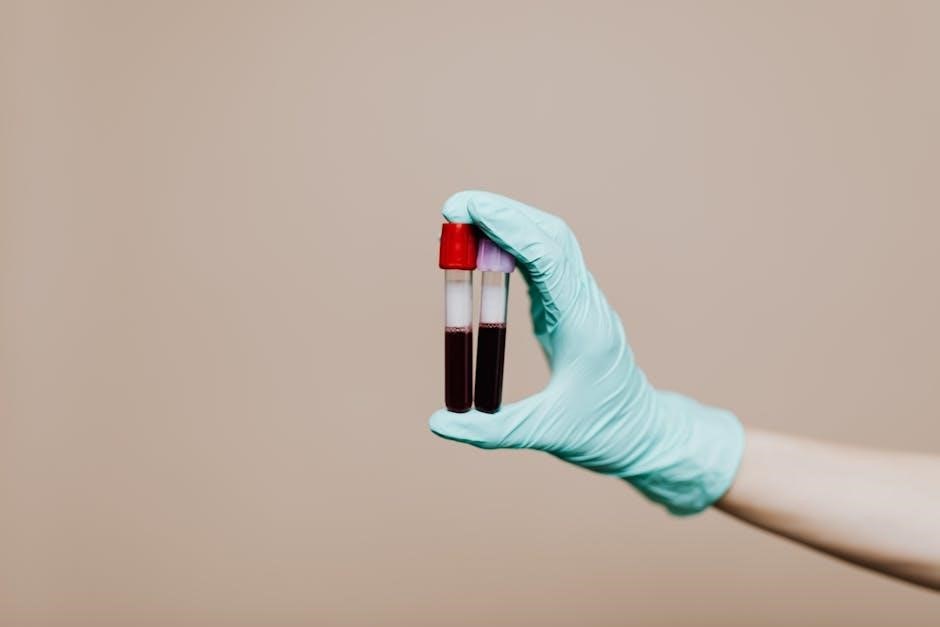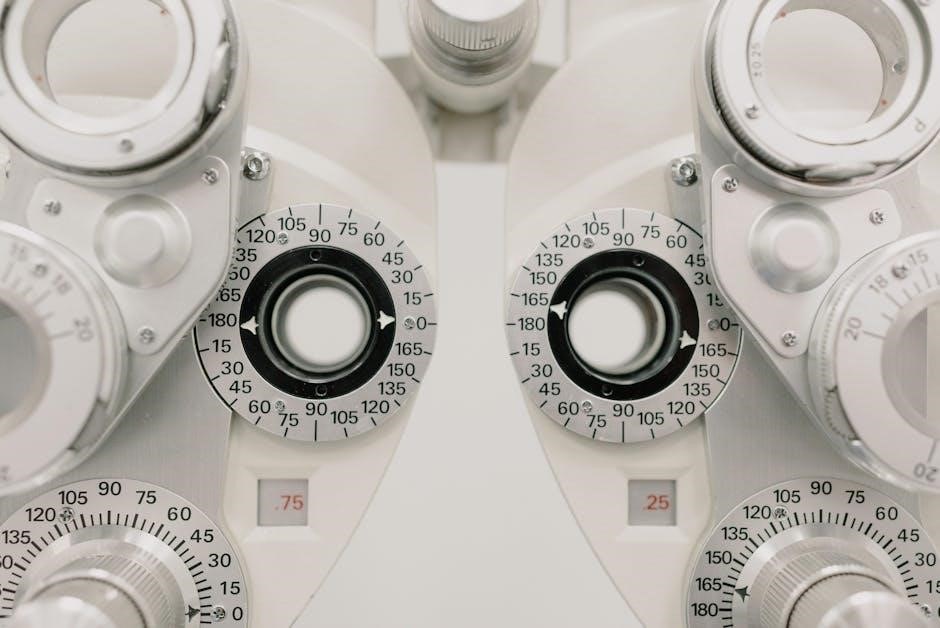
The Head-Impulse Nystagmus Test of Skew (HINTS) exam is a bedside oculomotor examination used to diagnose stroke and differentiate central versus peripheral vestibular disorders․ It combines three key assessments: the Head-Impulse Test, Nystagmus Test, and Test of Skew, providing critical insights into acute vestibular syndrome (AVS)․ A negative HINTS exam is more sensitive than early MRI diffusion-weighted imaging in ruling out stroke within the first 48 hours, with a specificity of 96%․ This non-invasive, quick, and cost-effective tool is increasingly valued in clinical practice, particularly in emergency and neurological settings, for its ability to predict brainstem strokes and guide timely interventions․
What is the HINTS Exam?
The HINTS exam is a bedside oculomotor assessment combining three tests: the Head-Impulse Test (HIT), Nystagmus Test, and Test of Skew (TOS)․ It evaluates vestibular function to differentiate central (brainstem or cerebellar) from peripheral (inner ear) causes of vertigo․ HIT detects vestibular loss, nystagmus identifies abnormal eye movements, and TOS reveals skew deviation․ A positive HINTS exam suggests central pathology, such as a brainstem stroke, while a negative result strongly rules out stroke with high specificity․ Its simplicity and non-invasive nature make it a valuable tool in acute settings, particularly for diagnosing stroke in patients with acute vestibular syndrome (AVS)․
Importance of the HINTS Exam in Diagnosing Stroke
The HINTS exam is a critical diagnostic tool for identifying stroke, particularly in patients with acute vestibular syndrome (AVS)․ It combines the Head-Impulse Test, Nystagmus Test, and Test of Skew to assess vestibular function and brainstem integrity․ A negative HINTS exam is more sensitive than early MRI diffusion-weighted imaging in ruling out stroke within the first 48 hours, with a specificity of 96%․ This makes it invaluable for early detection and differentiation of central versus peripheral causes of vertigo․ Its bedside availability and non-invasive nature enable rapid decision-making, reducing delays in stroke diagnosis and treatment․ This exam is particularly useful for predicting brainstem strokes, which are often missed in initial evaluations․

Components of the HINTS Exam
The HINTS exam comprises three key assessments: the Head-Impulse Test (HIT), Nystagmus Test, and Test of Skew (TOS)․ These evaluations help distinguish central from peripheral vestibular dysfunction․

Head-Impulse Test (HIT)
The Head-Impulse Test (HIT) assesses the vestibulo-ocular reflex (VOR) by rapidly moving the patient’s head horizontally while observing the eyes for corrective saccades․ A normal response indicates intact peripheral vestibular function, while an abnormal response, marked by catch-up saccades, suggests central or labyrinthine dysfunction․ Fixation saccades during HIT are a key indicator of vestibular pathology․ This test is critical in identifying stroke-related deficits and distinguishing central from peripheral causes of vertigo․ The HIT’s sensitivity in detecting acute stroke makes it a valuable component of the HINTS exam, particularly in emergency settings․
Nystagmus Test
The Nystagmus Test evaluates the presence, type, and characteristics of nystagmus (involuntary eye movements) to distinguish central from peripheral vestibular disorders․ During the test, the patient’s eyes are observed under direct gaze, lateral gaze, and with fixation․ Peripheral nystagmus is typically unidirectional and suppressed by fixation, while central nystagmus is bidirectional and not suppressed․ The absence of fixation saccades in peripheral vestibular disorders contrasts with their presence in central causes․ This test is crucial in acute vestibular syndrome (AVS) to identify stroke-related nystagmus patterns, aiding in early diagnosis and differentiation․ Its findings, combined with other HINTS components, enhance diagnostic accuracy in clinical settings․
Test of Skew (TOS)
The Test of Skew (TOS) evaluates vertical eye misalignment by observing refixation saccades when one eye is covered and then uncovered․ The examiner alternately covers each eye with their hand, starting with the right, then the left, and notes any corrective vertical or diagonal eye movements․ A positive TOS indicates central vestibular dysfunction, such as brainstem or cerebellar stroke, while a negative result suggests a peripheral cause․ Skew deviation is a key finding in central lesions, particularly in the posterior circulation․ This test, combined with nystagmus patterns and head impulse results, helps differentiate stroke from peripheral vestibular disorders, enhancing diagnostic accuracy in acute vestibular syndrome (AVS)․

How to Perform the HINTS Exam
The HINTS exam involves a systematic approach to assessing vestibular function․ It includes the Head-Impulse Test, Nystagmus Test, and Test of Skew, performed in sequence to evaluate eye movements and alignment․ Proper preparation ensures accurate results, with the patient seated upright․ Each test provides distinct insights into vestibular pathology, aiding in the differentiation between central and peripheral causes․ The exam is quick, bedside, and requires minimal equipment, making it a practical tool for clinicians to diagnose acute vestibular syndrome and predict stroke effectively․ Detailed checklists and training resources are available to guide healthcare providers in mastering the technique․
Preparation for the Exam
Proper preparation is essential for conducting the HINTS exam effectively․ Begin by positioning the patient upright on a chair or examination couch, ensuring their head is straight․ Cover one of the patient’s eyes with your hand and observe the uncovered eye for corrective movements during the head impulse test․ A quiet, well-lit environment minimizes distractions․ Use an OSCE checklist to ensure all components—Head-Impulse Test, Nystagmus Test, and Test of Skew—are systematically evaluated․ Clinicians should be well-trained in recognizing normal and abnormal findings to interpret results accurately․ Adequate preparation ensures reliable outcomes, making the HINTS exam a valuable diagnostic tool for acute vestibular syndrome and stroke assessment․
Step-by-Step Procedure
The HINTS exam is performed in three sequential steps: the Head-Impulse Test (HIT), Nystagmus Test, and Test of Skew (TOS)․ Begin with the HIT by gently but firmly turning the patient’s head 20-30 degrees to one side while observing for corrective eye movements․ Next, assess for spontaneous or gaze-evoked nystagmus, noting its direction, amplitude, and characteristics․ Finally, perform the TOS by covering and uncovering each eye to detect vertical misalignment․ Each step provides critical insights into vestibular function and central pathways, aiding in differentiating peripheral from central causes of vertigo․ A systematic approach ensures accurate and reliable results․
Interpreting Results
Interpreting the HINTS exam involves analyzing the Head-Impulse Test (HIT), Nystagmus Test, and Test of Skew (TOS) to differentiate central from peripheral vestibular disorders․ A normal HIT suggests intact vestibular function, while corrective saccades indicate peripheral deficits․ Unidirectional nystagmus may signal central causes like stroke, whereas bidirectional patterns could indicate peripheral issues․ Skew deviation suggests central vestibular dysfunction, whereas no skew supports peripheral causes․ Combining these results helps diagnose conditions like acute vestibular syndrome, with high sensitivity for stroke detection, exceeding early MRI DWI in the first 48 hours․ Accurate interpretation requires understanding each test’s implications and correlating findings with clinical context․

Advantages of the HINTS Exam
The HINTS exam offers high sensitivity in diagnosing stroke, particularly in acute vestibular syndrome, and is non-invasive, allowing bedside assessment․ It is more sensitive than early MRI diffusion-weighted imaging in the first 24-48 hours, making it a valuable diagnostic tool for timely interventions․
High Sensitivity in Diagnosing Stroke
The HINTS exam demonstrates remarkable sensitivity in identifying strokes, particularly in cases of acute vestibular syndrome (AVS)․ Studies indicate that a negative HINTS result can effectively rule out stroke with a specificity of 96%, surpassing early MRI diffusion-weighted imaging within the first 48 hours post-symptom onset․ This high sensitivity stems from its ability to detect subtle oculomotor abnormalities indicative of central nervous system involvement․ By accurately identifying patients who require immediate neurological intervention, the HINTS exam serves as a critical tool in emergency settings, reducing diagnostic delays and improving patient outcomes․ Its precision makes it invaluable for clinicians in acute care scenarios․
Non-Invasive and Bedside Procedure
The HINTS exam is a non-invasive and bedside procedure, making it highly accessible in clinical settings․ It requires no specialized equipment, relying instead on clinical observation and physical examination techniques․ Patients can remain seated or lying down, ensuring comfort and ease of performance․ This bedside approach eliminates the need for invasive procedures or imaging, reducing costs and potential discomfort․ Its simplicity allows clinicians to conduct the exam in emergency departments, outpatient clinics, or even at the patient’s bedside, providing timely assessments without delays․ This practicality enhances its utility in diverse healthcare environments, ensuring rapid and accurate evaluations for patients with suspected vestibular or neurological conditions․
Comparison with Early MRI Diffusion-Weighted Imaging
The HINTS exam surpasses early MRI diffusion-weighted imaging (DWI) in diagnosing stroke within the first 24-48 hours, particularly in acute vestibular syndrome (AVS)․ While MRI DWI is highly sensitive for detecting ischemic changes, it may miss early or small infarcts in posterior circulation strokes․ The HINTS exam, with its specificity of 96%, offers a more reliable method to rule out stroke in AVS patients․ Its bedside accessibility and rapid performance make it a valuable alternative to MRI, especially in settings where imaging resources are limited․ This comparison underscores the clinical utility of HINTS in providing timely and accurate diagnoses, guiding appropriate management and reducing the risk of missed strokes․

Clinical Significance of the HINTS Exam
The HINTS exam is crucial for diagnosing stroke in acute vestibular syndrome, offering higher sensitivity than early MRI DWI․ It helps differentiate central from peripheral vestibular disorders and predicts brainstem strokes effectively, guiding timely interventions and improving patient outcomes significantly․

Acute Vestibular Syndrome (AVS)
Acute Vestibular Syndrome (AVS) is characterized by rapid onset of dizziness, nausea, vomiting, head motion intolerance, nystagmus, and unsteady gait․ It typically lasts more than 24 hours and can persist for days to weeks․ AVS often results from peripheral vestibular disorders, such as labyrinthitis, but can also indicate central causes, including stroke․ The HINTS exam is a critical diagnostic tool in AVS, helping to differentiate between central and peripheral origins․ Early identification of central causes, like brainstem strokes, is vital for timely treatment and improved outcomes․ AVS requires a thorough clinical evaluation, with the HINTS exam playing a pivotal role in guiding management strategies․
Differentiating Central vs․ Peripheral Vestibular Disorders
The HINTS exam is a bedside tool that helps differentiate central from peripheral vestibular disorders․ Peripheral vestibular disorders, such as labyrinthitis, typically present with a negative Head-Impulse Test, absent fixation saccades, and no vertical skew․ In contrast, central causes, including brainstem strokes, often show abnormal Head-Impulse Test results, presence of fixation saccades, and vertical skew․ Nystagmus characteristics, such as direction-changing or upbeat nystagmus, further support central pathology․ A positive HINTS exam strongly suggests a central vestibular disorder, while a negative exam is more indicative of peripheral causes․ This differentiation is crucial for guiding further investigations and treatment, particularly in acute settings like stroke evaluation․
Predicting Brainstem Strokes
The HINTS exam is critical in predicting brainstem strokes, particularly in patients with acute vestibular syndrome (AVS)․ A positive HINTS exam, characterized by abnormal horizontal head impulse, upbeat nystagmus, and skew deviation, strongly suggests central pathology․ These findings are associated with lesions in posterior circulation arteries, such as the PICA, AICA, or SCA, which supply the brainstem and cerebellum․ Early identification of these signs allows for prompt neuroimaging and intervention, improving outcomes․ The HINTS exam’s ability to predict brainstem strokes makes it a vital tool in acute care settings, guiding timely management and reducing the risk of delayed diagnosis․

Learning and Mastering the HINTS Exam
Systematic teaching and hands-on training are essential for mastering the HINTS exam․ Clinicians benefit from structured education, including OSCE checklists and interactive resources, to ensure proficiency in performing and interpreting the exam accurately․
Systematic Teaching and Training
Systematic teaching and training are crucial for mastering the HINTS exam․ Structured educational programs, including workshops and online modules, provide clinicians with the necessary skills to perform the exam accurately․ These programs often incorporate video demonstrations, case studies, and hands-on practice to enhance learning․ Additionally, the use of OSCE checklists ensures that clinicians can assess their proficiency and identify areas for improvement․ Regular practice and feedback from experienced instructors further refine their technique, enabling them to confidently and effectively administer the HINTS exam in clinical settings․ Such comprehensive training is essential for ensuring the accuracy and reliability of HINTS exam results․
OSCE Checklist for HINTS Exam
An OSCE checklist for the HINTS exam is a valuable tool for ensuring a systematic and thorough assessment․ It includes key steps such as properly positioning the patient, performing the head-impulse test, assessing for nystagmus, and conducting the test of skew․ The checklist also evaluates the clinician’s ability to interpret findings and differentiate between central and peripheral vestibular disorders․ By following the checklist, examiners can ensure consistency and accuracy in their evaluation․ Additionally, it serves as a learning aid for trainees, helping them master the examination technique and improve their diagnostic skills․ Regular use of the checklist enhances clinical competence and ensures reliable results in both training and real-world settings․
Resources for Further Study
For further study, numerous resources are available to enhance understanding and mastery of the HINTS exam․ The HINTS exam PDF guide by Crystal Visions provides comprehensive study materials, including exam tips and practice questions․ Geeky Medics offers an in-depth guide with step-by-step instructions and video demonstrations․ Additionally, OSCE checklists and interactive tools are available online to help clinicians and students prepare effectively․ These resources cover exam preparation, interpretation of results, and practical tips for improving diagnostic accuracy․ They are invaluable for both learners and professionals seeking to refine their skills in performing and interpreting the HINTS exam accurately and efficiently in clinical settings․

Exam Preparation Tips
Effective exam preparation involves strategic planning, active revision, and consistent practice․ Utilize time management techniques, review study guides, and practice past papers to enhance performance and confidence․
Time Management Strategies
Effective time management is crucial for exam success․ Allocate study sessions based on syllabus weightage, prioritize challenging topics, and incorporate regular breaks to maintain focus․ During exams, assess the time allocated per question and adhere strictly to avoid running out of time; Practice mock tests under timed conditions to enhance speed and accuracy․ Utilize a structured schedule to ensure comprehensive revision and avoid last-minute cramming․ By organizing study time efficiently, candidates can approach exams with confidence and achieve optimal results․ This method ensures a balanced preparation and reduces exam-day stress significantly, leading to better performance and outcomes․
Effective Revision Techniques
Active recall is a powerful revision strategy, involving regular practice of past exam questions and case studies to reinforce memory․ Create flashcards for key concepts and review them frequently․ Mind mapping helps visualize relationships between topics, enhancing understanding․ Set specific goals for each study session and track progress․ Use spaced repetition to revisit material at increasing intervals, improving long-term retention․ Engage in group discussions or teach concepts to others to deepen comprehension․ Regularly review and condense notes into concise summaries․ Incorporate real-life examples to contextualize learning․ Consistency is key; dedicate time daily to revision rather than cramming․ These techniques ensure thorough preparation and improved performance․
Common Mistakes to Avoid
Common mistakes during exam preparation include procrastination, poor time management, and neglecting weak areas․ Many students overlook the importance of understanding exam formats and question types, leading to unnecessary errors․ Avoid cramming, as it reduces retention and increases stress․ Neglecting to practice with real-life examples and case studies can also hinder performance․ Overreliance on memorization without understanding concepts is another pitfall․ Additionally, ignoring the importance of rest and mental health can impair focus․ Stay calm during exams, avoid last-minute cramming, and ensure thorough preparation․ Focus on consistent practice and active recall to build confidence and mastery․ Learn from past mistakes to refine your approach․
The HINTS exam is a valuable diagnostic tool for stroke and vestibular disorders․ Its sensitivity and non-invasive nature make it crucial in clinical settings․ Continuous learning is essential for mastering this exam․

Final Thoughts on the HINTS Exam
The HINTS exam emerges as a critical bedside tool in diagnosing acute vestibular syndrome and stroke․ Its high sensitivity surpasses early MRI diffusion-weighted imaging, making it invaluable in clinical settings․ By combining the head-impulse test, nystagmus assessment, and test of skew, it offers a comprehensive evaluation․ Clinicians benefit from its non-invasive nature and rapid results, enabling timely interventions․ Continuous learning and systematic training are essential to master the HINTS exam, ensuring accurate diagnoses and improved patient outcomes․ As a reliable diagnostic method, it underscores the importance of bedside examinations in modern neurology and emergency medicine․
Importance of Continuous Learning
Continuous learning is vital for mastering the HINTS exam and staying updated with its clinical applications․ The exam’s effectiveness relies on accurate interpretation and technique, which require ongoing education and practice․ Resources like the HINTS exam PDF guide and OSCE checklists provide structured learning tools․ Clinicians must stay informed about the latest research and advancements in vestibular medicine․ Regular training ensures proficiency in differentiating central and peripheral causes of vertigo, ultimately improving diagnostic accuracy and patient outcomes․ Emphasizing continuous learning fosters competence and confidence in using the HINTS exam as a reliable diagnostic tool in acute care settings․